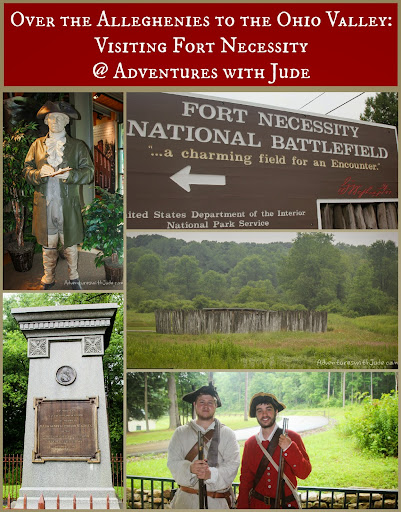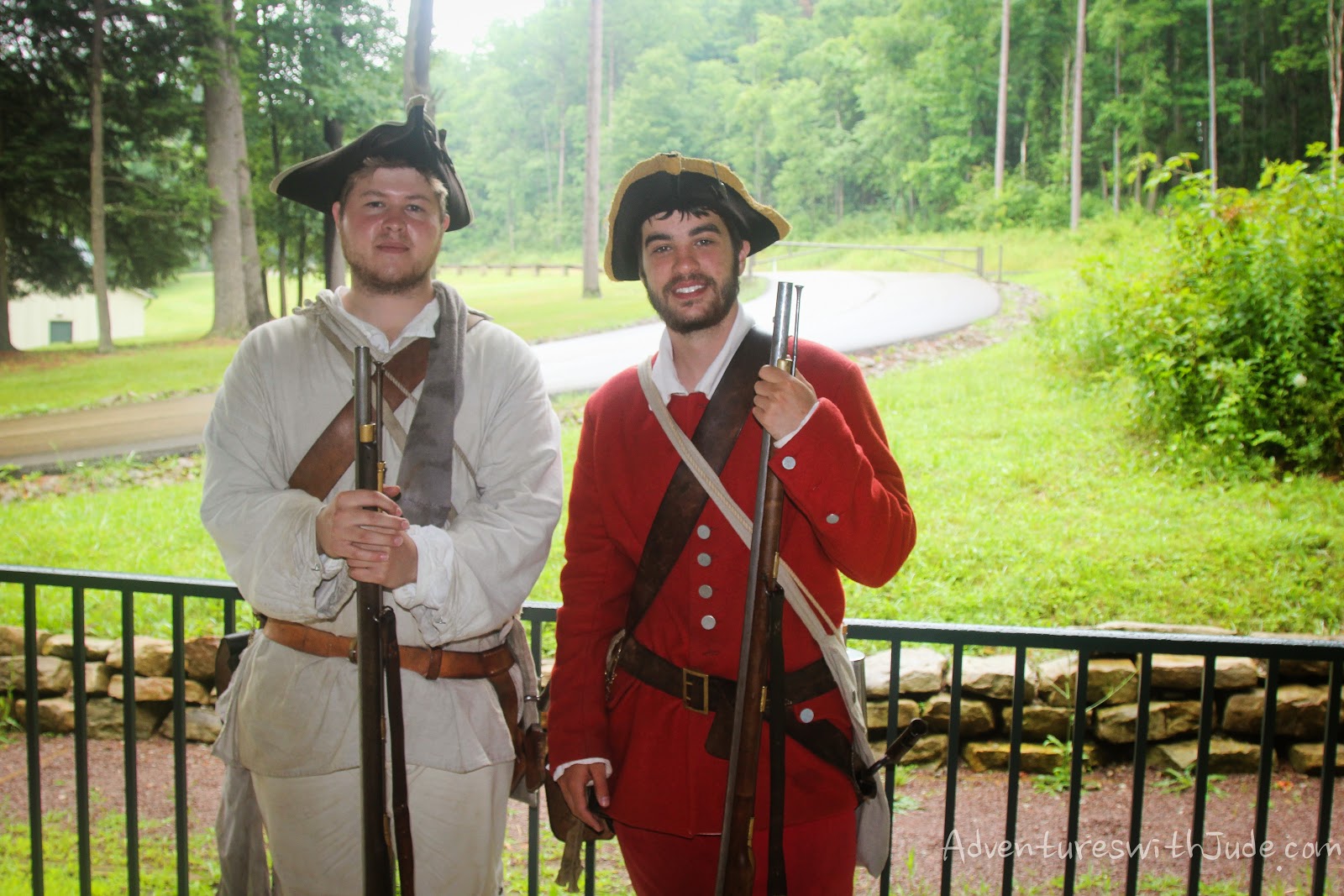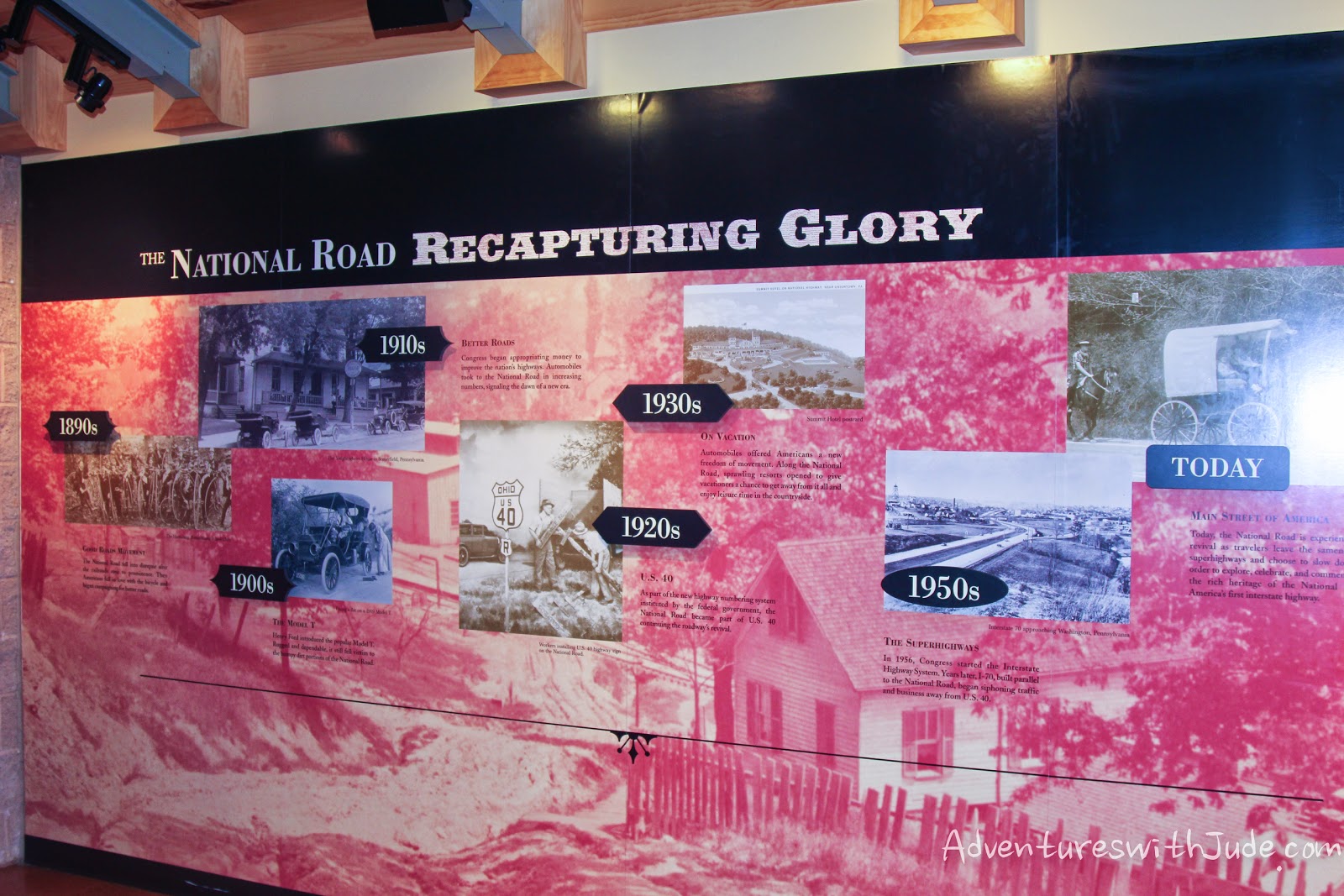Fort Necessity National Battlefield, the site of the first battle of the French & Indian War, is located on US 40 in Framington, PA. There is an admission charge of $5 for adults 16 and over; children under 15 are free. The main site consists of a Visitors' Center/Museum, the Great Meadows grounds, and Washington's Tavern, a stagecoach stop on the National Road. (After the Revolution, Washington returned to the area and purchased land; the Tavern was built in the early 1800s and named for him.) Satellite sites include Braddock's Grave and Jumonville Glen. Before you go, check to make sure the sites you wish to visit are open -- while the main Fort is open year round from dawn to dusk (Visitor's Center hours are 9 to 5), the other sites are only accessible seasonally. Due to the weather (it poured) and other plans (we wanted to visit the Flight 93 National Memorial on our way back to New Jersey), we only visited the more easily accessible Braddock's Grave.
When we first arrived, the Ranger suggested we begin with the 20-minute film. The first half is dedicated to the history of Fort Necessity, while the latter part is dedicated to the creation of the National Road (US 40). We opted to leave the Museum until the end of our visit in order to attend a scheduled education program about the life of a soldier stationed at Fort Necessity.
These two young gentlemen led the discussion. The "soldier" on the left was a recent West Virginia University grad, while the red-uniformed one is a student at Kutztown University. They are both part of the NPS Jobs for Students programs. Their role in the part was to explain about the life of a "British regular" who joined with Washington's group.
First, they discussed the type of man who joined the milita. In the 1700s, only landed white men could vote. While the soldier would draw a regular pay (8 pence/day), what they wanted was the severance pay at the end of their year of service: 60 acres of land. Most of the enlisters were "destitute of house and home," so many often joined for the security of a job and adventure. Daily rations included chipsbread (the precursor to hardtack), salt beef, and half a pint of rum each day. Because water sources were suspect, the rum rations would be added to water to help make it potable.
Ideally, every man who enlisted would receive a uniform. In reality, funding was so limited that often the officers wore uniforms and the rest looked the ragtag bunch they were. Those that received uniforms were issued red woolen jackets and pants, as well as "straight last" shoes. This uncomfortable footwear was issued for economy's sake - there were no left or right shoes to match. Wool was the fabric of choice for three reasons. Even if it was unbearably hot in summer, wool was comfortable for spring and fall and much appreciated in the cold of winters. Secondly, wool was a cheap fiber that didn't burn easily. If there was one thing England had in massive quantities, it was sheep. The hallmark crimson dye was another economic concession. Men in undyed garments were easily lost sight of in the smoke of battle. Red dye came from the common and easily grown madder plant - again, it was cheap to produce.
Soldiers were issued either a smooth-bore musket or a rifle (usually the more affluent soldiers brought rifles with them) and a wood and leather box that held 18 gun cartridges. One would expect that the Army would require all soldiers to have functioning limbs, but they also required that enlistees had a full set of teeth. Shot and powder would be measured and wrapped in paper; teeth were required to rip open the cartridge to load the gun! Soldiers also carried a bayonet - it looked fearsome on a rifle, but in reality saw more use as a shovel or tent peg. Often soldiers would barter for a tomahawk - a small hatchet - from a Native American tribe.
After teaching about the history of the soldiers, they demonstrated about their muskets. Each had a smooth flintlock King Musket. The "Brown Bess" was the most common musket used by all armies during the colonial period. It had a smooth barrel, which meant it had a lot of power, but not a lot of accuracy. A little gunpowder was placed in the flint pan, and then the rest and the lead ball was put into the barrel of the musket and rammed into place. The flint hammer would be cocked, and the trigger pulled. A spark from the hammer ignited the powder in the pan, which would light the powder in the barrel and expel the ball. The term "flash in the pan," referring to something that starts strong but doesn't do anything, has its origins from the up to 25% misfire rate of the Brown Bess. One of the demonstrators joked that the first time the gun actually fired for him during a demo he was shocked it worked!
This lack of accuracy was a key reason why soldiers fought in battle lines -- basically, each side is facing a firing squad. The ball was 69 mm piece of lead, while the barrel width was 75 mm. The extra space kept the ball from shooting straight; it bounced it's way down the barrel and continued on whatever trajectory it found last. It had reasonable accuracy at 60-80 yards - but that meant if the bullet from your weapon could hit the soldier you were aiming at, theirs could hit you. The musket's range was about 200-300 yard, so backing up meant you were a little safer, but a lot less accurate. Combined with a 75% accuracy rating for the gun to actually fire, you needed a lot of people shooting at a broad target to do any damage. A rifle was more accurate because it had a threaded barrel, creating a "spin" on the ball. Imagine the difference between a poorly tossed football and a correctly snapped pass with a clear spiral. That's the difference between a smooth bore and rifled gun. The rifle is more accurate, but it comes with a price, literally. The cost between weapons determined what was given to infantrymen.
The leaders also asked if anybody knew what happened to gunpowder when it got wet? Answer: It is ruined. One of the reasons that Fort Necessity fell was because it was out in the open. Not only did it leave it vulnerable to attack, but it didn't provide for great storage of gunpowder. The day of the battle, it was pouring down rain (not unlike the day we visited). It meant that most of the British gunpowder got wet, while the cover of the trees helped the French powder from the deluge. They were on the edge of accuracy - only 60 yards from the woodline - but with wet powder and his enemy protected by the woods, Washington realized that he had no choice but to surrender - the first and only surrender of his career.
Since there was a momentary let up in the rain, we then headed out to the fort itself.
When he first arrived at Great Meadow, George Washington wrote that the meadow would be “a charming field for an encounter.” Taking in the stillness of the open field, we could see what would make a young, still-idealistic surveyor feel this way. After his first fight at Jumonville Glen, he wrote there was “something charming in sound” of bullets. After the loss of Fort Necessity, he never again referred to war as "charming." He returned to the area a year later; in July 1755 he was the aide-de-camp to Major General Edward Braddock. After the loss on the road to Ft. Duquesne and the retreat to the woods around Great Meadow, Washington no longer saw any glory in war: "The shocking Scenes which presented themselves in this Nights March are not to be described. The dead, the dying, the groans, lamentations, and crys ... of the wounded for help were enough to pierce a heart of adamant."
The original building and fence was torched by the French as part of Washington's surrender at the Battle of Fort Necessity. The fort was recreated by the National Parks Service in 1932 after extensive archeology. Earthworks were retrenched and the simple circular fort rebuilt. There are some guide signs posted, but what we really liked was the cellphone tour! By calling an automated number and then entering which numbered stop we were at along the way, we were able to learn about the history of the Fort.
The NPS is also working to restore the Great Meadow to its original size. Deforesting over the years significantly increased the size of the clearing. Saplings have been planted to help bring the woodline closer to historic accuracy.
The mowed area and plantings show the historic edge of the woods, and just how close the enemy was.
After we walked up the hill to Washington's Tavern (Fort Necessity National Battlefield's visitor's center is also the home of the museum for the National Road Heritage Corridor), we headed back into the museum. Although the rain had finally stopped (of course!), the playground was too wet to spend much time on. I loved the reproduction feel of it.
The interactive museum shows all "three" sides of the French and Indian War - British, French, and Native. The kids loved the symbols placed on placards. Britain was represented by a Crown, France by the fleur-de-lis, and the Native Americans by a turtle.
One of the things the boys really enjoyed were seeing some of the artifacts. We were all impressed by the detail in the Wampum, and Jude couldn't believe how soft the beaver pelt was.
Even though the original fort was destroyed by fire, excavators found a piece of the original fencing buried underground.
The centerpoint of the exhibit was this statute to honor the fallen soldiers of the Battle, with the interactive history lesson. What made it incredibly interesting is its placement in a rotunda, with the British perspective on one side, and the French on the other. One of the themes Luke has been exploring is who is "right" when it comes to war. This made for a fantastic discussion on how history is subject to which side you are on -- a concept that comes to the forefront again in the American Civil War.
After the story of the French and Indian War, the museum skips forward to the Early Republic and the history of the National Road -US 40. Built to connect the territories west of the Ohio Valley with the eastern states, it was the first federally funded road in the United States. Beginning in Cumberland, Maryland, it transverses Pennsylvania, (West) Virginia, Ohio, Indiana and Illinois to reach the Mississippi River at St. Louis. Over the years, US 40 combined with other highly traveled roads (portions of the frontier byways Zanes Trace and Oregon Trail, and the Victory Highway in the western US), expanded to run from coast to coast, and currently runs from Atlantic City, NJ to Park City, UT.
After we completed our tour, we headed down the National Road to Braddock's Grave. The cellphone tour continues here as well, giving an overview of the site before you head into from the parking lot to the historical site. With the parking lot built on a hill, and needing to cross the Braddock Road Trace, it's definitely a site that isn't compatible with region's frequent sleet and snow.
Braddock's Road Trace
A year after the Battle of Fort Necessity, George Washington returned to the area as the aide-de-camp to General Edward Braddock. Their mission was to recapture Fort Duquesne from the French, but the British troops were ambushed and slaughtered just after they crossed the Monongahela River. They retreated back down to about a mile from Great Meadow, where Braddock died of his wounds. George Washington led the funeral service. He had the men bury Braddock in the center of the road, and the militia stomped over it to hide the grave. (Washington feared Native Americans would ransack the grave and take the corpse as a trophy.)
Braddock's Road was used as a main thoroughfare through the Allegheny Mountains. In 1804, maintenance workers for the National Road unearthed a body near where Braddock was supposed to have been buried, and his uniform buttons found nearby confirmed the identity. Braddock's remains were then re-interred atop a nearby hill.
Braddock's Grave Monument
While most consider the Revolution to have begun with the shots at Lexington and Concord, Massachusetts, it is here in this small meadow where the fight for American freedom truly began. The Ohio Valley was where Britain began to assert her authority in the colonies, trying to gain control over the land -- and then piling taxes on the colonists to pay for the forays. Only about three hours from the National Battlefields of Antietam
and Gettysburg (each about 3 hours away), visiting Fort Necessity is well worth the side trip to learn more about two important events that helped make America.
©2012- 2014 Adventures with Jude. All rights reserved. All text, photographs, artwork, and other content may not be reproduced or transmitted in any form without the written consent of the author. http://adventureswithjude.com



























Wow - that is a really neat place. I would love to take my kids there someday! Thanks for writing about it.
ReplyDeleteHi Meg! What an interesting place. I'd like to visit Fort Necessity one day. I love the old wooden fort. Great pictures! :D
ReplyDelete